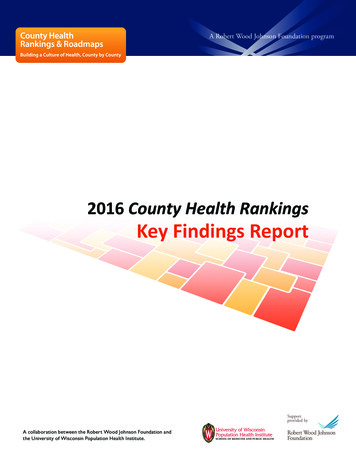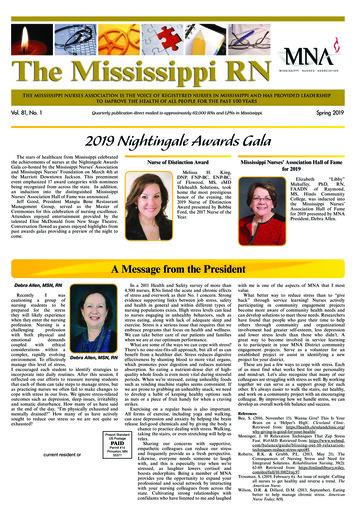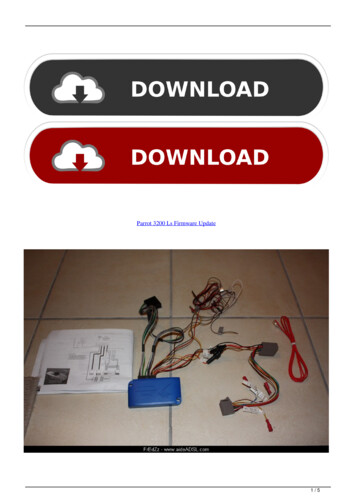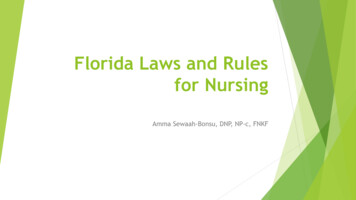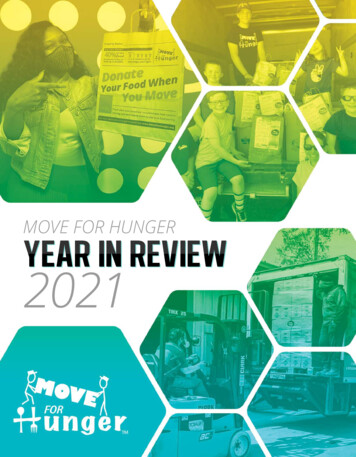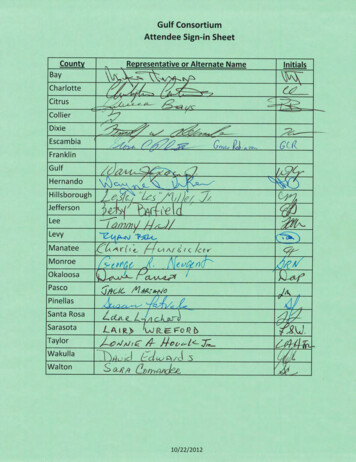
Transcription
UPDATE ON OIL SPILLCOMMISSION / ELEMENTSOF RESTORATION PLANEric Dohner & Michael Bomar, Tetra TechGulf ConsortiumMeetingTallahassee, FLOctober 22, 2012
CREATION OF THE COMMISSION Section 496 of Chapter 2011‐142 of the Laws of Floridacreates the Commission on Oil Spill ResponseCoordination Prepare a reportevaluating off shore oilspill responsecapabilities for reviewand approval by theBoard of Trustees byJanuary 1, 2013
MEMBERS OF THE COMMISSIONNameTitleAgency/EntityGeorge GainerBOCC ChairmanBay County Board of County CommissionersDave ParisotBOCC Vice ChairmanOkaloosa County Board of County CommissionersGrover RobinsonBOCC District IV CommissionerEscambia County Board of County CommissionersJoseph ParrishBOCC District IV CommissionerFranklin County Board of County CommissionersWarren YaegerBOCC ChairmanGulf County Board of County CommissionersLane LynchardBOCC District V CommissionerSanta Rosa County Board of County CommissionersTBDWakulla County BOCCWakulla County Board of County CommissionersBill ImfeldWalton County BOCCWalton County Board of County CommissionersTami TorresDeputy Chief Financial OfficerFlorida Department of Financial ServicesLeslie PalmerDirector, Division of AquacultureFlorida Department of Agriculture and Consumer ServicesRichard KnudsonFlorida Scientific Support CoordinatorFlorida Fish and Wildlife Conservation CommissionDr. Kendra GoffState ToxicologistFlorida Department of HealthDanny KilcollinsPlanning ManagerFlorida Division of Emergency ManagementTom BeckDirector, Division of Community DevelopmentFlorida Department of Economic OpportunityRussell KentSpecial Counsel for LitigationFlorida Office of the Attorney GeneralJennifer FitzwaterChief of Staff, Florida Department ofEnvironmental ProtectionExecutive Office of the GovernorTBDFlorida Department of Environmental Protection
IMPORTANCE OF THE COMMISSION
IMPORTANCE OF THE COMMISSION
TO DATE Public Comments by email:floilspillcommission@tetratech.com All Materials mission.htm Three Meetings (Aug 22, Sept 12, and Oct 3) Identified & Discussed Issues Stakeholder Presentations Reviewing Recommendations
DRAFT RECOMMENDATIONS Planning & Operational Recommendations: Area Contingency Plans (ACPs) Activate Branches Cooperative Agreements Command & Control Recommendations: Spill of National Significance (SONS) Leverage Existing Emergency Operation Centers (EOCs) Stafford Act vs. National Response System Education Resources & Logistics Recommendations: Representation Vessels of Opportunity (VOO) Guidance Real Time Reporting (GATOR)
FLORIDA ECOSYSTEM RESTORATION PLAN BackgroundPurpose & ObjectivesRequirementsSchedule
PLAN BACKGROUND
PLAN’S OBJECTIVES & REQUIREMENTS Restoring & Conserving Habitat Restoring Water Quality Replenishing & Protecting LivingCoastal & Marine Resources Enhancing Community Resilience Economic Recovery Projects
DIVERSITY
RESTORING & CONSERVING HABITAT
RESTORING & CONSERVING HABITAT
RESTORING & CONSERVING HABITAT
RESTORING WATER QUALITY
RESTORING WATER QUALITY
RESTORING WATER QUALITY
Green Algae (Chlorophyta)HalimedaCodiumCaulerpa sertularoidesCaulerpa racemosa
REPLENISHING & PROTECTING LIVINGCOASTAL & MARINE RESOURCES
REPLENISHING & PROTECTING LIVINGCOASTAL & MARINE RESOURCES
REPLENISHING & PROTECTING LIVINGCOASTAL & MARINE RESOURCES
REPLENISHING & PROTECTING LIVINGCOASTAL & MARINE RESOURCES
ENHANCING COMMUNITY RESILIENCE
ENHANCING COMMUNITY RESILIENCE
ENHANCING COMMUNITY RESILIENCE
ECONOMIC RECOVERY PROJECTS
SCHEDULE January 2013
hael.bomar@tetratech.com850.837.9278Gulf ConsortiumMeetingTallahassee, FLOctober 22, 2012
Florida Association of CountiesRESTORE Act MeetingWednesday, September 19, 2012Loews Don CeSar HotelPinellas County (St. Pete Beach, Florida)Attendees: See Attached.Staff in attendance: C Holley, G Delegal, C Mosteller, S James, V RogersMeeting OverviewChris Holley began by informing attendees that future meetings will be noticed once the GulfConsortium is formed. For now, the Association is encouraging each county to consider publiclynoticing the meetings if more than one commissioner is attending. He asked that if there wereany counties that did not publicly notice this meeting but had more than one commissioner inattendance that they excuse all but one commissioner from the room.Mr. Holley then introduced the FAC leadership in attendance, President Bryan Desloge and 1stVice President Grover Robinson.Then Mr. Holley informed the attendees that the Association had asked Commissioners GroverRobinson and Susan Latvala to be the leaders of the group.Commissioner Susan Latvala welcomed the attendees and thanked them for their commitmentto the hard work ahead.Commissioner Grover Robinson also welcomed the attendees and stressed the need to find away to work together towards success.Mr. Holley then called roll for the 23 Gulf Coast counties with there being at least onerepresentative present from each county.Next Mr. Holley introduced staff and the attendees introduced themselves.Ms. Ginger Delegal, FAC General Counsel, then made an announcement regarding the SunshineLaw and its application to some of the attendees. The Association has been informed by thePage 1 of 3
Commission on Oil Spill Response’s special counsel of the current process counties are using topublicly notice the RESTORE Act meetings. Ms. Delegal informed those at the meeting that theCommission’s special counsel asked that Commission members not discuss Commissionbusiness with each other and that the Association remove any agenda items relating to theCommission.Mr. Holley then gave the attendees background information including the history of theDeepwater Horizon oil spill, the Mabus report, the passage of the RESTORE Act, an overview ofthe August meeting in Bay County and the Interlocal Agreement. Next, he gave an overview ofthe meeting agenda, excluding Commission items.Agenda Item # 1 – Gulf Consortium Joint Public Entity Creation / Steps ForwardMark Mustian, Of Counsel to Nabors, Giblin & Nickerson, provided a briefing on the mechanicsfor forming the Gulf Consortium and answered individual county questions on the contents ofthe Interlocal Agreement and execution procedures. After discussion, a straw poll (via roll call)was taken as to which counties were willing to take the Interlocal Agreement to their BOCCs foraction. Each county, except Franklin and Gulf, agreed to take the Interlocal Agreement beforetheir BOCC.Agenda Item #2 – Transition BudgetDoug Darling presented a proposed budget to the attendees to fund the administrative costsincurred in creating the Consortium and it transitioning it to operational status. The Associationwould send the invoices to each of the 23 counties. Each county share would be based on theformula contained in the RESTORE Act.Discussion ensued and Chris Holley asked if any county would be unwilling to approve itscounty allocation. There were no negative comments.Agenda Item # 3 – Staff Report on Other Activities / Contacts MadeUnited States TreasuryChris Holley provided a briefing on an initial conference call had with the US Department ofTreasury concerning its delegated duties for federal rule development under the RESTORE Act.The call was introductory in nature as to the counties’ Gulf Consortium creation process. Mr.Holley reported to the attendees that he informed the Department that the Association hasPage 2 of 3
asked the Governor to partner with the counties in the Gulf Consortium. There will be a followup call with them next week. The Association invited the Department to come meet withFlorida’s counties and have offered for Association staff and representatives to go up to DC tomeet with them. The Department clarified to Mr. Holley that there will be no reimbursement ofadmin costs until there is money in the trust fund. The Department is drafting rules now; theywill be published in November.Office of the GovernorThe Governor has appointed Florida’s member to the Gulf Coast Ecosystem RestorationCouncil. There will be an announcement soon.NRDAJohn Wayne Smith reported having talked to Mimi Drew, Florida Trustee, Gulf Coast EcosystemRestoration Task Force. She will go back to Atlanta for another meeting soon.Agenda Item # 4 – Next MeetingChris Holley proposed the next meeting being held on October 22, 2012. Details would follow.Closing comments were provided by Commissioners Grover Robinson (Escambia) and SusanLatvala (Pinellas)The meeting was adjourned.Page 3 of 3
FAC RESTORE ACT Meeting AttendeesSeptember 19, 2012Pinellas County (St. Pete dCathyD. nHinoteHosackHouck, Jr.HughesHunsickerHuntJackelJohnsonJohnstonSRI InternationalNEP, Sarasota BayDixie CountyWRS CompassEPC of Hillsborough CountyManatee CountyJefferson CountyNabors, Giblin & NickersonNature ConservancyJackson CountyWalton CountyWakulla CountyTaylor CountyHDR EngineeringWalton CountyPinellas CountyWalton CountyCharlotte CountyTampa Bay Region Planning CouncilFloridian Partners-Hillsborough CountyLeon CountyTetra TechTetra TechAudubon FloridaHernando CountyEPC of Hillsborough CountyTaylor CountyCollier CountyMonroe CountyHillsborough CountyGulf Restoration NetworkGilchrist CountyLee County NRDMiami-Dade CountyACT Env. & InfrastructureWalton CountySarasota CountyTaylor CountyCSA InternationalManatee CountyLee CountyFranklin CountyFl. Coastal & Ocean Coalition, ENE Inc.Hillsborough CountyPage 1 of 3
FAC RESTORE ACT Meeting AttendeesSeptember 19, 2012Pinellas County (St. Pete exMarkDavidBobRobertArleneEdJohn nsnyderStoltzfusSwansonWalton CountyEscambia CountyState Representative, District 53 / Lucas, Green & MagazinePinellas CountyNOAAFlorida Wildlife FederationSarasota CountyBaskerville Donovan EngineersPasco CountyOcean ConservancyMW Consulting-Monroe CountySanta Rosa CountyDefenders of WildlifeLevy CountyTampa Bay Estuary ProgramMonroe CountyOkaloosa CountyFlorida Department of Environmental ProtectionTaylor CountySarasota CountySarasota CountyCitrus CountyGuardian CRMFloridian Partners-Monroe CountyMonroe CountyEscambia CountyHillsborough CountyBryant, Miller & Olive-Sarasota & Manatee CountiesBay CountyLee CountyFranklin CountyCollier CountyAlachua CountyMote MarineMonroe CountyCharlotte CountyVolusia CountyBay CountyPeebles FirmHernando CountyPinellas CountyPasco CountyCharlotte CountyHDRPage 2 of 3
FAC RESTORE ACT Meeting AttendeesSeptember 19, 2012Pinellas County (St. Pete ilsonWolfeWrefordMonroe CountyGilchrist CountyBay CountyEPC of Hillsborough CountyValente AdvisersEscambia CountyFlorida Institute of OceanographyHillsborough CountyBaskerville Donovan EngineersMW Consulting-Monroe CountyCitrus CountyPinellas CountyManatee CountyCollier CountyGulf CountyPasco CountyGulf of Mexico AllianceSarasota CountyPage 3 of 3
This page intentionally left blank.
Florida Commission on Oil Spill Response CoordinationReport 2: An Analysis of the Effectiveness of the Use ofthe Incident Command System in the DeepwaterHorizon (DWH) IncidentSummary of how the Incident Command System functioned during DWH,with recommendations for improvementContentsExecutive Summary .11Introduction.22Description and Application of the Incident Command System.32.1Purpose of the Incident Command System . 32.2Organizational Structure and Function of the Incident Command System . 42.2.1 Incident Command Post . 72.2.2 Incident Action Plan . 72.2.3 Support Facilities . 82.2.4 Area Contingency Plans . 82.3Application of Incident Command System . 92.3.1 USCG Incident Management Handbook . 92.3.2 Florida’s Comprehensive Emergency Management Plan (CEMP) . 113Use of Incident Command System during DWH incident .153.1Initial Implementation . 153.2Organizational Structure of Incident Command System during DWH . 163.2.1 National Incident Command . 163.2.2 Federal ICS Components . 173.2.3 State and Local ICS Structure . 203.3Operation during the DWH Event . 213.3.1 Command and Control. 213.3.2 Information Gathering . 223.3.3 Information Dissemination . 233.3.4 Source Control . 243.3.5 Resource Procurement . 243.3.6 Resource Deployment . 253.3.7 Policy Review and Implementation. 263.3.8 Strategic Planning. 273.3.9 Finance and Reimbursement . 28Report 2: An Analysis of the Effectiveness of the Use of the Incident Command System in the Deepwater Horizon (DWH) Incidenti
Florida Commission on Oil Spill Response Coordination3.4Gulf Coast Incident Management Team .293.4.1 Current Status of the Gulf Coast Incident Management Plan .293.4.2 Florida’s Role in the Implementation Plan .31456Effectiveness of ICS during the DWH incident .324.1Scalability and Span-of-Control .324.2Communication among Federal, State and Local Entities.334.3Sharing of Information, Data and Monitoring Results .33Recommendations for the Incident Command System.345.1Need for pre-event orientation and training (coordination, drills, information sharing,etc.) .355.2Approaches for Scaling and/or Adjusting for Large Events.36Appendices .37Appendix A: GC-IMT Data Reporting Process during DWH .37Appendix B: Abbreviations and Acronyms .39iiReport 2: An Analysis of the Effectiveness of the Use of the Incident Command System in the Deepwater Horizon (DWH) Incident
Florida Commission on Oil Spill Response CoordinationExecutive SummaryFollowing the explosion of the Deepwater Horizon (DWH) offshore drilling rig on April 20, 2010,federal, state, and local governments and the responsible party (RP) faced an unprecedentedchallenge in the Gulf of Mexico. Never before had a subsea drill unit malfunction of thatmagnitude occurred in U.S. waters. This incident called on the existing governing frameworks foroffshore activities and disaster response, both of which cut across every level of governance,from national to local, and involved multiple actors at each of those levels.Section 496 of Chapter 2011-142 of the Laws of Florida created the Commission on Oil SpillResponse Coordination. The commission was charged with preparing a final report that identifiespotential changes to state and federal laws and regulations, which will improve responsecapabilities and processes, and protect Florida’s people and resources. This report is one ofseveral reports that will help form the basis for the final report. The analysis conducted for thisreport tries to answer the question of whether existing federal and state laws for oil spill planningand response are adequate to deal with large-scale spills such as the DWH incident.Future governmental activity could be influenced by several factors, including conditions in theGulf region, independent inquiries, judicial actions and the availability of data for further study. Asmultiple state and federal agencies seek to better our emergency preparedness and responsecapabilities, it will be important to understand the current framework for addressing suchincidences.This report recommends considering the following for improved response capabilities in futureincidents: Set clearer guidelines on span of control and flexible nature of the Incident CommandSystem (ICS) for earlier involvement of local ICS structuresImplement training for government officials on ICS and emergency response protocol,specifically for oil spillsEnhance doctrine within adopted ICS handbooks to facilitate communication with ICSstructures at all levels of governmentDevelop further guidance on Spill of National Significance/National Incident Command(SONS/NIC) that integrates the ICS doctrine, specifically Joint Information Center (JIC)and Public Information Offices (PIOs)Report 2: An Analysis of the Effectiveness of the Use of the Incident Command System in the Deepwater Horizon (DWH) Incident1
Florida Commission on Oil Spill Response Coordination1 IntroductionThe ICS is a standardized, on-scene, and all-hazards incident management approach used byall levels of government, many nongovernmental organizations (NGOs) and the private sector toestablish a common process for planning and managing resources in emergency responseefforts. The ICS was intended to be scalable, adaptable, and dynamic to ensure ease ofimplementation and execution to incidents of varying size and scope. The ICS structure outlinesresponsibilities and functions, thereby reducing potential conflicts, and improving information flowamong all participating organizations. 1 The ICS is not only applied in the U.S., it is commonlyrecommended by the United Nations when member states must address national disasters andemergencies. 2 A number of agencies in Canada 3 and the United Kingdom 4 also use the ICS intheir planning and response efforts.The ICS was initially established in the early 1970s as a means for managing the efforts tocontrol rapidly moving wildfires in California. Before implementing the ICS, emergencyresponders identified a number of problems as encumbrances to having well-organized, effectiveincident management. The critical issues consisted of the following: Overwhelming numbers of individuals reporting to one personDifferent emergency response organizational structures among responding agenciesLack of reliable incident informationInadequate and incompatible communicationsLack of structure for coordinated planning among agenciesUnclear lines of authorityTerminology differences among agenciesUnclear or unspecified incident objectives 5Despite the use of the ICS, these issues surfaced again during and following the Exxon Valdezoil spill in 1989 in Prince William Sound, Alaska, and decision makers began adapting the ICSinto a more flexible protocol capable of working with varied organizational structures and in anysituation regardless of jurisdictional boundaries. In 2004 the U.S. Department of HomelandSecurity (DHS) in 2004 officially adopted this system for oil spill response.1OSHA.gov, What are the advantages of an ICS/UC?, Emergency Response eTool, Occupational Safety & HealthOrganization (OSHA). Available at: http://www.osha.gov/SLTC/etools/ics/ics uc relation.html#Advantages2See the World Health Organization (WHO), Improving hospital safety and disaster response in Tajikistan. DisasterPreparedness and Response. Available at: ster-response-in-tajikistan3See ICS Canada at: http://www.icscanada.ca/4See Incident Command: Fire and Rescue Manual - Volume 2: Fire Service Operations. The United Kingdom’s Fire andRescue Service (FRS), December, 2008. Available at: cidentcommand3rd5The National Response Team, Unified Command Technical Assistance Document, 2007. Available lAttachmentsByTitle/A-820PubUCTAD/ ort 2: An Analysis of the Effectiveness of the Use of the Incident Command System in the Deepwater Horizon (DWH) Incident
Florida Commission on Oil Spill Response CoordinationToday, incidents demand so many resources and skills that one local, state, or federal agencycould not possibly provide them all; therefore, the ICS attempts to provide a way for manyagencies to work together smoothly under one management system.2 Description and Application of the Incident CommandSystemAs explained above, the ICS provides a structure for multiple actors to work efficiently andeffectively to respond to an incident. The ICS is a subcomponent of the National IncidentManagement System (NIMS), which provides a framework for how incidents are managedacross all homeland security activities, including prevention, protection, response, mitigation andrecovery. This framework establishes a core set of concepts, principles, procedures,organizational processes, terminology and standard requirements for use within the ICS. 6 TheUnited States Coast Guard (USCG), an agency in DHS, has developed its own framework forimplementing the NIMS, which uses the structure of the ICS. This is in the Incident ManagementHandbook (IMH) published by the USCG. 7Florida has also adopted ICS and incorporated key components into the Florida ComprehensiveEmergency Management Plan (CEMP). The CEMP defines the responsibilities of thegovernment, private sector, and volunteer and nongovernmental organizations (NGOs) thatmake up the State Emergency Response Team (SERT). The CEMP is intended to ensure thatall levels of government are able to mobilize as a unified emergency organization to safeguardthe state’s residents and visitors. As a part of the CEMP, SERT and various state agencies havealso developed incident-specific applications of ICS for the different types of emergencies.2.1 Purpose of the Incident Command SystemThe ICS is intended to be a widely applicable management system that promotes effective andefficient management. The ICS achieves these objectives by setting out a protocol thatintegrates issues such as facilities, equipment, personnel, procedures and communications asthey relate to the various agencies involved in an incident. The system further describes anoptimal organizational structure for individuals and agencies. As defined in the December 2008edition of the NIMS, “ the ICS is a fundamental form of management established in a standardformat, with the purpose of enabling incident managers to identify the key concerns associated6Department of Homeland Security, National Incident Management System, December 2008. Available at:http://www.fema.gov/pdf/emergency/nims/NIMS core.pdf7United States Department of Homeland Security, United States Coast Guard, Incident Management Handbook. August,2006. Available at: 06.pdfReport 2: An Analysis of the Effectiveness of the Use of the Incident Command System in the Deepwater Horizon (DWH) Incident3
Florida Commission on Oil Spill Response Coordinationwith the incident—often under urgent conditions—without sacrificing attention to any componentof the command system.” 8The ICS was developed to provide the following benefits: Establish an integrated organizational structureAdapt to differing incidents and their innate complexitiesCreate a framework free of jurisdictional boundariesIncorporate federal, state, local, and RP representatives in the response planning andactivitiesOrganize groups around a common organization, planning, logistic, and administrativestructureCreate one protocol capable of being used across disciplinesEstablish a common terminologyBuild an organizational structure developed modularlyAllow for centralized and coordinated incident planning2.2 Organizational Structure and Function of the Incident CommandSystemAs part of ICS, a comprehensive organizational structure has been established for either singlejurisdiction or multijurisdictional use (see Figure 1). For smaller incidents, a Single IncidentCommander is designated; for larger, multijurisdictional incidents, a Unified Command (UC) isestablished. 9 For incidents that affect many regions, an Area Command is implementedconsisting of an individual Area Commander that assists with logistical and administrative issues.Also, Incident Commanders (ICs) can be assigned from individual agencies or jurisdictions. Thisgroup is designated as Incident Command, and acts as a single integrated managementorganization.8Department of Homeland Security, National Incident Management System, December 2008. Available at:http://www.fema.gov/pdf/emergency/nims/NIMS core.pdf9OSHA.gov, About ICS/US and the NRS, Emergency Response eTool. Occupational Safety & Health Organization (OSHA).Available at: ort 2: An Analysis of the Effectiveness of the Use of the Incident Command System in the Deepwater Horizon (DWH) Incident
Florida Commission on Oil Spill Response CoordinationCommand StaffIncident CommanderPublic Information OfficerLiaison OfficerSafety OfficerGeneral StaffOperationsSectionPlanning SectionLogistics SectionFinancial/Admin. SectionFigure 1. Incident command structure.Working in concert with the Incident Command is the Command Staff, which consists of thePublic Information Officer, Safety Officer and Liaison Officer. Those responsible for the functionalaspects of the incident command structure are the General Staff. Within the ICS structure, it isprescribed that reporting to Incident Command should be conducted by a Section Chief for eachof the functional elements of ICS: Operations, Planning, Logistics and Finance/Administration(see Figure 1 above).The Operations Section has as its principal goal lifesaving and responder safety, along withresponsibility for establishing situational control and restoring normal operations. Once this isestablished, the Operations Section shifts its focus to developing tactics for incident-relatedactivities. Within the Operations Sections is a built-in structure for addressing span of control.The Operations Section can be divided into Branches, Divisions or Groups, and Resources aseach element grows in siz
Report 2: An Analysis of the Effectiveness of the Use of the Incident Command System in the Deepwater Horizon (DWH) Incident i Report 2: An Analysis of the Effectiveness of the Use of the Incident Command System in the Deepwater Horizon (DWH) Incident Summary of how the Incident Command System functioned during DWH,



